| Cape gannet | |
|---|---|
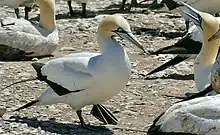 | |
| Cape gannet, Bird Island, Lamberts Bay, South Africa | |
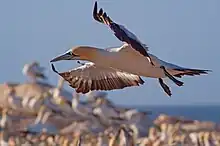 | |
| Cape gannet in flight | |
| Scientific classification | |
| Domain: | Eukaryota |
| Kingdom: | Animalia |
| Phylum: | Chordata |
| Class: | Aves |
| Order: | Suliformes |
| Family: | Sulidae |
| Genus: | Morus |
| Species: | M. capensis |
| Binomial name | |
| Morus capensis (Lichtenstein, MHC, 1823) | |
| The breeding range of the Cape gannet is confined to six islands along the coast of Southern Africa, viz. Bird Island (Algoa Bay), Malgas Island, and Bird Island (Lambert's Bay) in South Africa. And the Penguin Islands of Mercury Island, Ichaboe Island and Possession Island in Namibia.
Extant (breeding)
Extant (non-breeding) | |
| Synonyms | |
|
Sula capensis | |
The Cape gannet (Morus capensis) is a large seabird of the gannet family, Sulidae.
They are easily identified by their large size, black and white plumage and distinctive yellow crown and hindneck. The pale blue bill is pointed with fine serrations near the tip; perhaps because of the depth and speed of the gannet's dive when fishing (depending on altitude, gannets hit the water at speeds of between 40 and 120 km/h (25 and 75 mph)[2]), its beak has no external nostrils into which the water might be forced.
Taxonomy
German naturalist Hinrich Lichtenstein described the Cape gannet in 1823.
The Sulidae, the gannets and boobies, appeared about 30 million years ago. Early Sulidae fossils most resembled the boobies, although they were more aquatic, with the gannets splitting off later, about 16 million years ago. The gannets evolved in the northern hemisphere, later colonising the southern oceans. The most ancient extant species may be the Abbott's booby, possibly the sole survivor of an otherwise extinct separate lineage.[3] A 2011 genetic study of nuclear and mitochondrial DNA suggests that the ancestor of the gannets arose around 2.5 million years ago before splitting into northern and southern lineages. The latter then splitting into the Cape and Australasian gannets around 0.5 million years ago.[4] The three gannets are generally considered to be separate species forming a superspecies, though they have also formerly been classified as subspecies of the northern gannet (Sula bassanus).[5]

Description
When seen in flight the snow-white body with the black tail, primaries and secondaries, and dark bill makes them easy to identify. At closer range the distinctive golden crown and nape, which gradually becomes white on the neck, is noticeable. Juveniles and immatures are dark brown with a pale bill, and can resemble the dark-coloured boobies at first glance.
Adults are about 84–94 cm (33–37 in) long and have a 171–185 cm (67–73 in) wingspan and weigh ca. 2.6 kg (5.7 lb).
The Cape gannet is identified from the Australasian gannet by the all-black tail, a longer black stripe down the throat (from underneath the beak) and more extensive black on the face, but all of these features are difficult to identify unless at close proximity. The Cape gannet is also very similar to the northern gannet, but the latter differs from its entirely white tail and its wings, which are only black at the tip. It also is similar to the blue-footed booby (Sula nebouxii).

Breeding
Gannet pairs may remain together over several seasons. They perform elaborate greeting rituals at the nest, stretching their bills and necks skywards and gently tapping bills together.
Cape gannets begin breeding in August or September. Typically the clutch is a single bluish egg, which soon becomes soiled. Both parents are actively involved in the incubation process which lasts for 42 to 46 days until hatching. Gannets use their foot webs to incubate the egg. The foot webs, which are richly irrigated with blood vessels are wrapped around the egg.
The hatchling is black, naked and blind, it weighs only about 70 g (2.5 oz), but within three weeks its body mass is one third of that of an adult. At eight weeks the chick outweighs the adult, and this remains so until it becomes a fledgling at 95–105 days of age.
Feeding
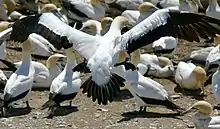
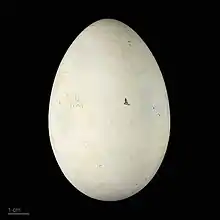
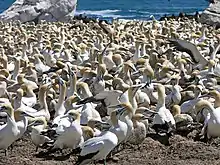
Cape gannets are powerful fliers, using mainly a flap-gliding technique, which is more energy consuming than the dynamic-soaring favoured by albatrosses. As all Sulids, they are fish-eating birds that plunge-dive from considerable height.
Status and distribution
Breeding and non-breeding range
The breeding range of the Cape gannet is restricted to southern Africa in three islands off Namibia and three islands off South Africa. They normally nest in large and dense colonies on flat islands or on flat ledges of the steeply sloping Mercury Island off Namibia. The world population was estimated in 1996 to number about 340,000 birds, with 12% in Namibia and 88% in South Africa. The largest colony of this bird, with over 140,000 birds, is found on Malgas Island, South Africa. Several birds have occasionally been found breeding on offshore Australian islands, together with Australasian gannets, although the Cape species is never represented by more than a few pairs.[6]
The non-breeding range of the Cape gannet extends from the coastal waters off the Gulf of Guinea on the west coast of Africa, to Mozambique on the east coast. They seldom occur farther offshore than 100 km, though records of birds more than 200 km offshore exist for both the Atlantic and Indian Oceans.
Population trends
Numbers of Cape gannets at the Namibian islands have declined considerably between 1956 and 2000 from 114,600 to 18,200 breeding pairs respectively, an 84% decrease in less than fifty years. This contrasts with the trends at the South African islands where numbers have increased about 4.3 times during the same period, from 34,400 to 148,000 breeding pairs.
Vagrancy
Vagrancy to the northern Atlantic Ocean has been reported for the Cape gannet on several occasions, but until 2016 was believed to be unproven.[7] Crochet and Haas[8] examined the status of the species in the western Palearctic realm. They list a number of historical claims which had not been accepted by national bird records committees, and analyse the single record which had hitherto been widely accepted, a juvenile recovered offshore from Western Sahara in 1966. In relation to the latter bird, they conclude that a mistake had occurred; the original data placed the bird inland, in Chad, with the offshore Western Saharan location being the result of an attempt to correct this to a more plausible location. A retransposition of the original latitude and longitude gives a location off the Namibian coast, well within the regular wintering range of the species. As a result, they recommended that the Cape gannet be deleted from the Western Palearctic list. However, on 14 April 2016, a Cape gannet was photographed at sea off Flores in the Azores.[9][10] The species has been discussed as a possible vagrant to Britain and Ireland, and there have been a number of claimed sightings, including one in December 2020 off the Isle of Wight, but there is yet to be an accepted record in the Western Palearctic apart from the Azores record.[11][12] One Spanish record from 1985 has been accepted as either a Cape gannet or an Australasian gannet.[11]
Individuals have also been photographed in other locations far from the species' usual range, including off Peru in 1999 and Oman in 2004.[11]
References
- ↑ BirdLife International (2018). "Morus capensis". IUCN Red List of Threatened Species. 2018: e.T22696668A132587992. doi:10.2305/IUCN.UK.2018-2.RLTS.T22696668A132587992.en. Retrieved 15 March 2022.
- ↑ Beak Protects during Dives: Cape Gannet, AskNature
- ↑ del Hoyo, Josep; Elliott, Andrew; Sargatal, Jordi; Christie, David A.; de Juana, Eduardo, eds. (2013). "Family Suildae: Gannets and boobies". Handbook of the Birds of the World Alive. Barcelona: Lynx Edicions. doi:10.2173/bow.sulida1.01. S2CID 216477098. Retrieved 19 May 2018.
- ↑ Patterson, S.A.; Morris-Pocock, J.A.; Friesen, V.L. (2011). "A multilocus phylogeny of the Sulidae (Aves: Pelecaniformes)". Molecular Phylogenetics and Evolution. 58 (2): 181–91. doi:10.1016/j.ympev.2010.11.021. PMID 21144905.
- ↑ Nelson, J. Bryan (2010) [1978]. The Gannet. London: A&C Black. p. 18. ISBN 978-1-4081-3857-1.
- ↑ Pizzey, Graham; Knight, Frank (2007). The Field Guide to the Birds of Australia. HarperCollins. pp. 102–03.
- ↑ Paterson A.M. and N.J. Riddiford (1990). "Does the Cape Gannet Enter European Waters?" British Birds 83(12):519–526.
- ↑ Crochet, Pierre-André and Marcel Haas (2008). Western Palearctic list update: deletion of Cape Gannet Dutch Birding 30(2):103–4.
- ↑ Alfrey, Peter; Legrand, Vincent. Azores Rare and Scarce Birds Report 2016 (PDF) (Report). Azores Bird Club. p. 22. Archived (PDF) from the original on 25 November 2020. Retrieved 25 November 2020.
- ↑ Jones, Josh (21 January 2017). "The top 10 Western Palearctic vagrants of 2016". Birdguides. Archived from the original on 25 November 2020. Retrieved 25 November 2020.
- 1 2 3 Garner, Martin (26 September 2007). "Focus On: identification of Cape Gannet". Birdguides. Archived from the original on 16 December 2020. Retrieved 16 December 2020.
- ↑ Viles, Sam (16 December 2020). "Review of the Week: 9-15 December 2020". Birdguides. Archived from the original on 16 December 2020. Retrieved 16 December 2020.
Further reading
- Crawford (1997). Cape Gannet. In: The Atlas of Southern African Birds Vol. 1: Non-passerines. Harrison, J. A. Allan, D. G., Underhill. L. G., Herremans, M., Tree, A.J., Parker, V. & Brown, C.J. (eds), pp. 28–29. BirdLife South Africa, Johannesburg.
- du Toit, M. & Cooper, J. (2002). Cape Gannet. In: Proposal for inclusion of species in Annex 2 of the Agreement on the Conservation of African-Eurasian Migratory Waterbirds (AEWA, an agreement under UNEP/CMS). Avian Demography Unit, Cape Town.
External links
- Species factsheet – BirdLife International
- Species text – The Atlas of Southern African Birds
- Fact sheet – Avian Demography Unit, University of Cape Town
- Fact file with images and movies – ARKive
- "Beak protects during dives" – Ask Nature
- "Spinning makes safe dive" – Ask Nature
